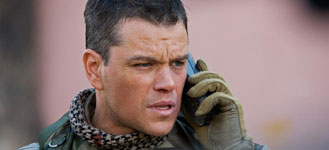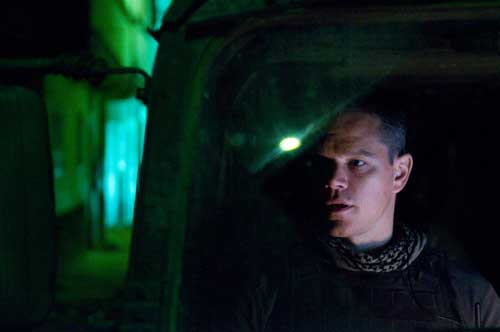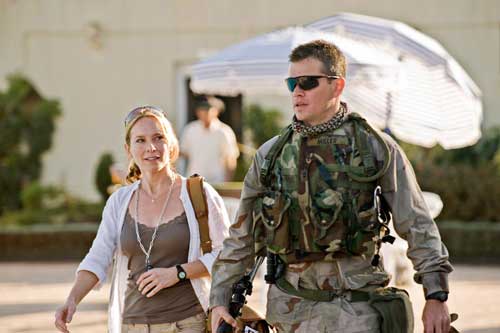Green Zone (Universal)
The Bourne Constipatem
Spoiler alert! There were no weapons of mass destruction in Iraq! Believe it or not, this bit of knowledge immediately dispels more than half of the intrigue found in Green Zone, a severely misguided excursion that ultimately delivers on none of its expected fronts.
Matt Damon plays Roy Miller, a U.S. Army officer on the hunt for weapons of mass destruction in Iraq in the wake of the U.S. invasion. After following verified intelligence to abandoned toilet factories and empty warehouses, he begins to suspect that something is not right—that our intelligence sources are, perhaps, not all they’re cracked out to be. Miller begins his own investigation of sorts, ignoring orders from his superiors and cooperating with competing intelligence officials on his quest for the truth.
But the “truth” he is searching for comes as no surprise to anyone who has at least been conscious during the last half-decade, and the search itself does not add anything new to our understanding of the situation. A lot of people were misled. A lot of people turned a blind eye. A lot of people acted on faulty intelligence. The film treats these kernels of knowledge like tremendous realizations, even as these concepts make for very old news.
So what is the purpose of Green Zone if not to intelligently portray or shed some kind of light on the mechanisms that led to the U.S. occupation of Iraq—neither of which the film attempts to do with any reasonable effort? The film comes across as a contemptible vanity project, allowing its makers to revel in the missteps—however gross—of U.S. policy in Iraq. The film makes no attempt to be revealing: assertions are stated and spewed in our direction, denying us any opportunity to draw our own conclusions. Further, there is no explanation or even exploration of motive for the U.S.-ascribed misdirection, beyond a broad understanding that forces of pure evil were surely in play.
This is but the tip of a self-assured, vitriolic anti-American sentiment conveyed throughout the film. Our soldiers blindly follow orders without any regard for purpose or consequence. They dig up children’s playgrounds, fire haphazardly, and pummel one another in a contest for scraps of intelligence. The Iraqi civilians are forced to scamper away to safety like ants in a rainstorm, lest they suffer the demoralizing consequences of going toe-to-toe with the American troops. Officer Miller is different, of course. He seems to be the only one who bothers to ask the obvious questions, the only one engaged in a military operation and not an all-out free-for-all.
Meanwhile, Saddam’s former Republican Palace in the violence-free “Green Zone” has been converted into a Sandals resort. Tourists pose and take pictures outside the compound. Soldiers and government suits lounge by the pool, cavort through corridors and hotel rooms, and snort and chug beer while the country around them is decimated by the senseless and trigger-happy American troops. But there is little acknowledgement on either front—one a tidied-up frat party and the other a high-stakes round of king of the hill—that a serious tactical offensive is underway.
No underhanded dealing or recognition of corruption goes unaccompanied by an American flag displayed conspicuously somewhere in the frame. The implication is a deeply-rooted entitlement and dishonesty inherent with American action, even as actual blame from the narrative is shared by just a selected few. Should we somehow miss a beat of condemnation, director Paul Greengrass abandons his jerky, hand-held framing style, steadying the camera just in time for every accusation, every inference of wrongdoing.
In their excitement to condemn our country, however, Greengrass and his team have forgotten to actually tell a story. The entirety of the film is focused on illuminating one point, so there is no natural plot progression, no character development, and no introspection—only manipulations used to abet its purpose. Characters, Damon’s included, are merely pawns in a clunky political demonstration behind the scenes. Even Amy Ryan, typically a highlight in any setting, cannot create a human being out of her cardboard reporter Lawrie Dayne when all she is allowed to do is swivel her head in suspicion and remark that something does not feel right.
Even so, no one seems particularly bothered by a bounty of commerce and capitalism—riches that our American freedoms also happen to afford us. Pizza Hut logos are emblazoned on the side of supply boxes being wheeled into the American base, just as beer flows aplenty out of Budweiser bottles in the Republican Palace. Not to mention that the film itself reportedly cost more than $100 million to produce after lengthy edits and reshoots—all made possible thanks in no small part to the very establishment Green Zone sets out to denounce.
More alarming, perhaps, is the indifferent and opportunistic treatment of the Iraqi people depicted in the film (a chronic problem in war movies involving the U.S.). They helplessly look on as American soldiers invade their territory and disrupt their lives, but they are given no voice or narrative of their own. If the film’s leading characters are merely pawns, then the Iraqi civilians are the squares of the chessboard itself: stormed over without regard, for the sake of expedient tragedy. Khalid Abdalla is given a bit of humanization as an Iraqi man who becomes Officer Miller’s translator, but he is then slapped with a familiar label (“Freddy”) and mostly used as a mouthpiece for the purported local sentiment “Get off my lawn!”
Just as the story does not bother to define its components and characters, the film gains traction as a faceless, nameless action flick. The opening scene portrays the start of the U.S. invasion with a jolt of explosions and artillery. The dark sky and shaky framework conceal the details of the occasion, but the combination of fire, scope, and sound achieve an artistic intensity missing from the rest of the film. The final act brings a chaotic, multi-layered chase through a maze of houses and narrow streets. Though it is not always clear who is chasing whom, the physical compilation registers at least (and at last) with a shallow excitement.
So Green Zone begins on a high note and approaches its conclusion with a lesser thrill, but it putters through its majority as little more than lightly-concealed and poorly-constructed propaganda. There is nothing in the film that adds to our understanding of the situation in Iraq or that even provides an entertaining and worthwhile experience. Compared to Paul Greengrass’ other work, including the latter two Bourne movies and the phenomenally moving United 93, this one is a mighty mess. And in the wake of The Hurt Locker taking home the Oscar for Best Picture (along with five other trophies), the film’s politics seem particularly inane and its effects inconsequential.




Directed by Paul Greengrass. Written by Brian Helgeland, inspired by the non-fiction book Imperial Life in the Emerald City by Rajiv Chandrasekaran.
Rated R for violence and language.
Runtime is 1 hour, 55 minutes.
Tickets & Showtimes» Watch the Trailer» Visit the Website»







Leave a Reply
You must be logged in to post a comment.